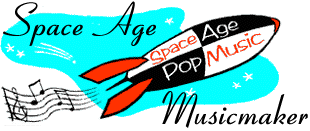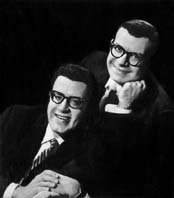Home · Listener's Guide · The Songs · Who's Who · Liner Notes · Selected Tracks · What's New · Search

Ferrante & Teicher
- Arthur Ferrante
- Born Arthur Ferrante, 7 Sept 1921, New York City
- Died 19 September 2009, Long Boat Key, Florida
- Louis Teicher
- Born 24 Aug 1924, Wilkes-Barre, Pennsylvania
- Died 3 August 2008, Highlands, North Carolina
 Ferrante & Teicher's work falls into two categories: prepared piano works and easy listening. After meeting as students, and then working as teachers, at Juilliard, they began to perform as a duo, primarily with classical groups, in 1946. They became a popular act on the "pops" symphony circuit. At the same time, they began experimenting with modifications to pianos, inserting objects into the stringbed, playing on the stringbed, striking keys or strings with blocks, and generally striving to figure out how to get the strangest possible sounds. Working before the first synthesizer, they succeeded in producing outworldly, almost electronic sounds. The pair described this musical transition:
Ferrante & Teicher's work falls into two categories: prepared piano works and easy listening. After meeting as students, and then working as teachers, at Juilliard, they began to perform as a duo, primarily with classical groups, in 1946. They became a popular act on the "pops" symphony circuit. At the same time, they began experimenting with modifications to pianos, inserting objects into the stringbed, playing on the stringbed, striking keys or strings with blocks, and generally striving to figure out how to get the strangest possible sounds. Working before the first synthesizer, they succeeded in producing outworldly, almost electronic sounds. The pair described this musical transition:
... it was while teaching that we began experimenting and creating new material for two pianos. For novelty numbers we stuffed wads of paper, sticks, rubber stops, masonite strings, cardboard wedges, and sandpaper into the pianos conjuring up weird effects (a la [John] Cage) resembling gongs, castanets, drums, xylophone, and harpsichord. Though we have gradually dropped many of these gimmicks, we fell that we have developed a musical style, and undoubtedly play in a manner that makes some former colleagues at Juilliard wince a bit.People who associate F&T with their easy listening music are often startled to hear their prepared piano works. There is nothing quite like them in the annals of recorded sounds. In fact, throughout this period, the duo was accused of using more than just pianos to produce these sounds, and they had to produce the following affadavit to convince Columbia Records before the label released their first single:
Divers persons upon hearing records of "Susanna's Last Stand" and "Caravan" and subsequent recordings by Ferrante and Teicher have asserted, implied or otherwise made known that such recordings were made by the use of various sundry instruments other than two pianos. Upon our solemn oath and undertaking we hereby assert, acknowledge, testify and state without equivocation or fear of contradiction that the only instruments played by Ferrante and Teicher in connection with the recordings of such compositions were two pianos.--Howard Scott and David Oppenheim, 24 Dec 1952Aside from a few very early albums of classical pieces, most of their albums up to about 1961, however, are entirely comprised of prepared piano pieces. However innovative and exciting this work was, however, it was tough to translate into commercial success. Their concerts were as likely to be held in gymnasiums, churches, cafeterias, and ballparks, as in concert halls. Much of what they earned went into new motors for their delivery truck. "If our wives hadn't worked," Teicher once said, "we never could have survived."
After joining United Artists in 1960, they added an orchestral accompaniment (usually arranged by Don Costa and conducted by Nick Perito) and quickly abandoned fiddling with their pianos. As High Fidelity magazine noted of their first album with Costa and Perito, Golden Piano Hits, their new sound was,
Devoid of gimmickry ... a fact that may appeal to the musical-minded more than those who listen, with both ears, for spectacular sonic surprises.It didn't take longer to figure out which was the larger audience. Despite the fact that their music would be described by the Washington Post as "Passionless ... lifeless ... numbing," F&T became one of the best-selling instrumental easy listening groups of the 1960s. They had immediate hits with their renditions of "Exodus" and the theme from "The Apartment," and over 10 Top 100 hits in the next 13 years. They continued to record a steady stream of 4 albums a year for United Artists until 1979, when they formed their own label, Avante Garde.
They often played to packed concert houses, appearing up to 100 times a year at their peak. They adopted near-identical hairstyles and wore matching big "birth control" glasses and loud tuxes. Time magazine once wrote, "In their patent leather shoes electric red jackets, black-rimmed spectacles and matching pompadour toupees they are the Tweedle twins of the concert stage." As their music grew tamer, their outfits grew wilder, eventually leading to what someone described as "straight out of a Liberace fire sale."
Although they retired from performing in 1989, they remained close friends and settled near each other in the Sarasota, Florida area. When interest in lounge and exotica music revived in the late 1990s, they hired a new manager and began working again in anticipation of a new series of recordings that would include new prepared piano sounds. Only the CD Denizens of the Deep came out of this.
"Although we were two individuals, at the twin pianos our brains worked as one," Art Ferrante recalled at the time of Teicher's death. Then, tongue in cheek, he added, "... as pianists it's ironic how we both ended up living on keys" (in Florida).
You can safely skip virtually everything recorded from the early United Artists LP, "Pianos in Paradise" on, though, unless you need a Muzak fix. The one prominent exception to this advice, however, is their best-selling album, Midnight Cowboy, which gained a lot of attention for its prominent use of Vinnie Bell's "watery" guitar effects. For most Space Age Pop fans, the prepared piano albums are the ones to seek out.
You can find out more about Ferrante and Teicher on their own website, www.ferranteandteicher.com. And you can also view them in a half dozen performances (both manic and mild) on YouTube.
Recordings
-
Prepared Piano Works
- Soundproof, Westminster WP 6014 (mono, 1956)
- Soundproof, Westminster WST 5011 (stereo, different songs from mono)
- Soundblast, Westminster WP-6041 (mono, same songs as Soundproof (stereo version))
- Adventure in Carols, Westminster WP 6021 (mono)
- Heavenly Sounds in Hi-Fi, ABC-Paramount ABC-221 (reissued as Easy Listening Favorites, MCA Special Products MCAD-20733)
- Ferrante and Teicher with Percussion, ABC-Paramount ABC-248
- Blast Off!, ABC-Paramount ABCS-285 (1958)
- Hi-Fireworks, Columbia CL 573
- Dynamic Twin Pianos, United Artists WWS 8504 (also released as Keyboard Kapers, UAL-3284)
Standard Easy-Listening Fare
- Themes from Broadway Shows, ABC-Paramount ABC-336
- Golden Piano Hits, United Artists WWS 8505
- The World's Greatest Themes, United Artists UAAS 6121
- Latin Pianos, United Artists UAS 6135
- West Side Story, United Artists UAS 6166
- Tonight, United Artists UAS 6171
- Pianos in Paradise, United Artists UAS 6230
- Love Themes, United Artists UAS 6282
- Concert for Lovers, United Artists UAS 6315
- 50 Fabulous Piano Favorites, United Artists UAS 6343
- The Roaring 20's, United Artists UA-LA072-F
- 30th Anniversary on Stage, CD
- Blast Off!, Varese Saraband CD
- All Time Greatest Hits, EMI/Capitol Special Products CD
- All Time Great Movie Themes, EMI/Capitol CD
- America Forever, Varese Saraband CD
- Christmas is So Special, EMI/Capitol CD
- Collection, Varese Saraband CD
- Denizens of the Deep, Varese Saraband CD
- Easy Listening Favorites, MCA Special Markets CD
- Great 1970s Motion Picture Themes, EMI/Capitol CD
- Greatest Hits, WEA/Atlantic/Curb CD
- Sound of Music, Varese Saraband CD
- ... and many more ...
S p a c e A g e P o p M u s i c
Home · Listener's Guide · The Songs · Who's Who · Liner Notes · Selected Tracks · What's New · Search
Email: editor@spaceagepop.com